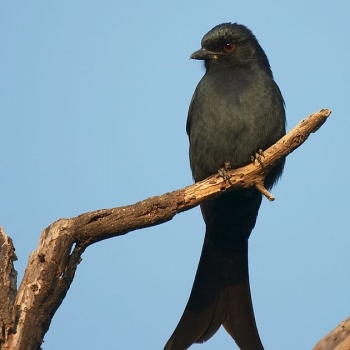| Line 2: | Line 2: | ||
[[Image:Fork-tailed_Drongo.jpg|thumb|350px|right|Photo by Leon]] | [[Image:Fork-tailed_Drongo.jpg|thumb|350px|right|Photo by Leon]] | ||
| − | |||
| − | |||
== Identification == | == Identification == | ||
The male is mainly glossy black, although the wings are duller. It is large-headed and has the forked tail which gives the species its name. The female is similar but less glossy. The bill is black and heavy, and the eye is red. The Fork-tailed Drongo is 25 cm long and 45 g heavy. It has short legs and sits very upright whilst perched prominently, like a shrike. | The male is mainly glossy black, although the wings are duller. It is large-headed and has the forked tail which gives the species its name. The female is similar but less glossy. The bill is black and heavy, and the eye is red. The Fork-tailed Drongo is 25 cm long and 45 g heavy. It has short legs and sits very upright whilst perched prominently, like a shrike. | ||
== Distribution == | == Distribution == | ||
The Fork-tailed Drongo is a common and widespread resident breeder in Africa south of the Sahara with being most comon in Botswana, Zimbabwe and the norther parts of South Africa and Mocambique. | The Fork-tailed Drongo is a common and widespread resident breeder in Africa south of the Sahara with being most comon in Botswana, Zimbabwe and the norther parts of South Africa and Mocambique. | ||
| + | ==Taxonomy== | ||
| + | Kingdom: Animalia | ||
| + | Phylum: Chordata | ||
| + | Class: Aves | ||
| + | Order: Passeriformes | ||
| + | Family: Dicruridae | ||
| + | Genus: Dicrurus | ||
| + | Species: D. adsimilis | ||
== Habitat == | == Habitat == | ||
Woodlands including riverine woodlands, moist and arid savanna, forest edges and grassland or fynbos with available perches, plantations of alien trees, gardens, farmyards and town parks. | Woodlands including riverine woodlands, moist and arid savanna, forest edges and grassland or fynbos with available perches, plantations of alien trees, gardens, farmyards and town parks. | ||
== Behaviour == | == Behaviour == | ||
These are aggressive and fearless birds, given their small size, and will attack much larger species, including birds of prey, snakes and humans, if their nest or young are threatened. They are attracted to bush fires. | These are aggressive and fearless birds, given their small size, and will attack much larger species, including birds of prey, snakes and humans, if their nest or young are threatened. They are attracted to bush fires. | ||
| − | + | <P>It flycatches or take prey from the ground, feeding on flying insects, moths and bees. Often stealing food from other birds. | |
| − | It flycatches or take prey from the ground, feeding on flying insects, moths and bees. Often stealing food from other birds. | + | <P> |
| − | |||
Monogamous, solitary nester building thin-walled, strongly woven cup nests in high tree-forks. Two to five eggs of highly varying colour. | Monogamous, solitary nester building thin-walled, strongly woven cup nests in high tree-forks. Two to five eggs of highly varying colour. | ||
== Bird Call == | == Bird Call == | ||
Revision as of 00:17, 31 July 2007
- Dicrurus adsimilis
Identification
The male is mainly glossy black, although the wings are duller. It is large-headed and has the forked tail which gives the species its name. The female is similar but less glossy. The bill is black and heavy, and the eye is red. The Fork-tailed Drongo is 25 cm long and 45 g heavy. It has short legs and sits very upright whilst perched prominently, like a shrike.
Distribution
The Fork-tailed Drongo is a common and widespread resident breeder in Africa south of the Sahara with being most comon in Botswana, Zimbabwe and the norther parts of South Africa and Mocambique.
Taxonomy
Kingdom: Animalia Phylum: Chordata Class: Aves Order: Passeriformes Family: Dicruridae Genus: Dicrurus Species: D. adsimilis
Habitat
Woodlands including riverine woodlands, moist and arid savanna, forest edges and grassland or fynbos with available perches, plantations of alien trees, gardens, farmyards and town parks.
Behaviour
These are aggressive and fearless birds, given their small size, and will attack much larger species, including birds of prey, snakes and humans, if their nest or young are threatened. They are attracted to bush fires.
It flycatches or take prey from the ground, feeding on flying insects, moths and bees. Often stealing food from other birds.
Monogamous, solitary nester building thin-walled, strongly woven cup nests in high tree-forks. Two to five eggs of highly varying colour.
Bird Call
The call is a metallic strink-strink.




